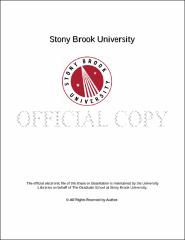| dc.identifier.uri | http://hdl.handle.net/1951/60240 | |
| dc.identifier.uri | http://hdl.handle.net/11401/70911 | |
| dc.description.sponsorship | This work is sponsored by the Stony Brook University Graduate School in compliance with the requirements for completion of degree. | en_US |
| dc.format | Monograph | |
| dc.format.medium | Electronic Resource | en_US |
| dc.language.iso | en_US | |
| dc.publisher | The Graduate School, Stony Brook University: Stony Brook, NY. | |
| dc.type | Thesis | |
| dcterms.abstract | Abstract 1:DPSC were obtained from pulp tissues of extracted wisdom teeth under protocols approved by the Stony Brook University Internal Review Board. Primary cells were isolated by enzymatic digestion and used from 3rd-5th passage. For experiments on differentiation, cultures were grown in alpha-MEM supplemented with 10% fetal bovine serum, 0.2 mM L-ascorbic acid 2- phosphate, 2 mm glutamine, 10 mM beta-glycerol phosphate either with or without 10 nM dexamethasone. After 21-days samples were examined using confocal microscopy of cells stained with Alexafluor 488-linked phalloidin and propidium iodide, and by scanning electron microscopy (SEM) and Energy dispersive X-ray Analysis (EDAX). Using SEM, biomineralization was observed on all the substrates in the presence of dexamethasone. In the case of P4VP extensive biomineralization was observed in the absence of dexamethasone, where the deposits were templated along the fibers. Minimal biomineralization was observed on PMMA fibers. EDAX spectra indicated that the deposits on both P4VP and PMMA fibers were comprised primarily of Ca and phosphorous, in a ratio consistent with hydroxyapatite. On PMMA carbonaceous deposits were observed in the absence of Dexamethasone. OCN and ALP mRNA expression is upregulated on P4VP fibers regardless of induction whereas the same occurs under induction only on PMMA. Proteins conformation on fiber is influenced by morphology and chemistry to affect cell differentiation and biomineralization. Abstract 2:To test the combined effects of biochemical and biophysical cues on stem cell differentiation, we used the mouse cell line C9 that expresses rhBMP-2 under control of the doxycycline-repressible promoter, Tet-Off. Cultures grown with doxycycline served as control, as did the parent cell line (C3H10T1/2) grown with and without doxycycline. Each cell line was grown on Si wafers coated with spun cast monodisperse polymer films of either polybutadiene (PB) where the substrate mechanical response can be controlled by film thickness, or on partially sulfonated polystyrene (PSS28) where surface charge is controlled by the degree of sulfonation. On PB, the moduli of cells expressing rhBMP-2 varied on day 1 by more than a factor of 2 when the substrate modulus was quadrupled and decreased substantially by day 5. Minimal variation in the moduli was observed for either the C3H10T1/2 cells or the C9 cells in the presence of doxycycline. On PSS28, the modulus of all cells was initially large, but decreased by day 3. Cell differentiation was monitored by qRT-PCR (OSX, ALP, OCN, BSP, SOX9, COLIIA, COLX and ALP) and biomineralization by SEM/EDX. Analyses of 14 day cultures showed that Cells expressing rhBMP-2 appeared osteogenic when cultured on SPS (BSP high, ACAN low) and chondrogenic (ACAN high) when cultured on PB; In the absence of doxycycline, the ECM deposited by the C9 cells was completely biomineralized with calcium phosphate on PSS28, while amorphous carbonaceous deposits were observed for the cells cultured on PB. Because occasional regions with small amounts of calcium phosphate deposition were also observed in C9 cultures grown with doxycycline and in C3H10T1/2 cultures grown with or without doxycycline, on PSS28, some mineralization of the ECM may occur independent of differentiation. These data suggest a model where substrate chemistry may control lineage choice and differentiation. | |
| dcterms.available | 2013-05-24T16:38:17Z | |
| dcterms.available | 2015-04-24T14:45:05Z | |
| dcterms.contributor | Walker, Stephen | en_US |
| dcterms.contributor | Simon, Marcia | en_US |
| dcterms.contributor | Rafailovich, Miriam | en_US |
| dcterms.contributor | Segal, Aaron. | en_US |
| dcterms.creator | Bherwani, Aneel K. | |
| dcterms.dateAccepted | 2013-05-24T16:38:17Z | |
| dcterms.dateAccepted | 2015-04-24T14:45:05Z | |
| dcterms.dateSubmitted | 2013-05-24T16:38:17Z | |
| dcterms.dateSubmitted | 2015-04-24T14:45:05Z | |
| dcterms.description | Department of Oral Biology and Pathology | en_US |
| dcterms.extent | 78 pg. | en_US |
| dcterms.format | Monograph | |
| dcterms.format | Application/PDF | en_US |
| dcterms.identifier | http://hdl.handle.net/1951/60240 | |
| dcterms.identifier | http://hdl.handle.net/11401/70911 | |
| dcterms.issued | 2012-08-01 | |
| dcterms.language | en_US | |
| dcterms.provenance | Made available in DSpace on 2013-05-24T16:38:17Z (GMT). No. of bitstreams: 1
StonyBrookUniversityETDPageEmbargo_20130517082608_116839.pdf: 41286 bytes, checksum: 425a156df10bbe213bfdf4d175026e82 (MD5)
Previous issue date: 1 | en |
| dcterms.provenance | Made available in DSpace on 2015-04-24T14:45:05Z (GMT). No. of bitstreams: 3
StonyBrookUniversityETDPageEmbargo_20130517082608_116839.pdf.jpg: 1934 bytes, checksum: c116f0e1e7be19420106a88253e31f2e (MD5)
StonyBrookUniversityETDPageEmbargo_20130517082608_116839.pdf.txt: 336 bytes, checksum: 84c0f8f99f2b4ae66b3cc3ade09ad2e9 (MD5)
StonyBrookUniversityETDPageEmbargo_20130517082608_116839.pdf: 41286 bytes, checksum: 425a156df10bbe213bfdf4d175026e82 (MD5)
Previous issue date: 1 | en |
| dcterms.publisher | The Graduate School, Stony Brook University: Stony Brook, NY. | |
| dcterms.subject | biomaterials, biomineralization, dental pulp stem cells, polymers, stem cells, tissue engineering | |
| dcterms.subject | Dentistry--Materials Science--Biomedical engineering | |
| dcterms.title | Substrate Chemistry, Mechanics And Morphology Influence Stem Cell Differentiation And Biomineralization | |
| dcterms.type | Thesis | |

